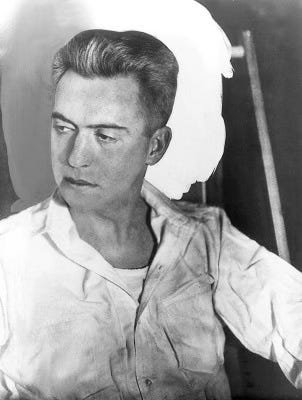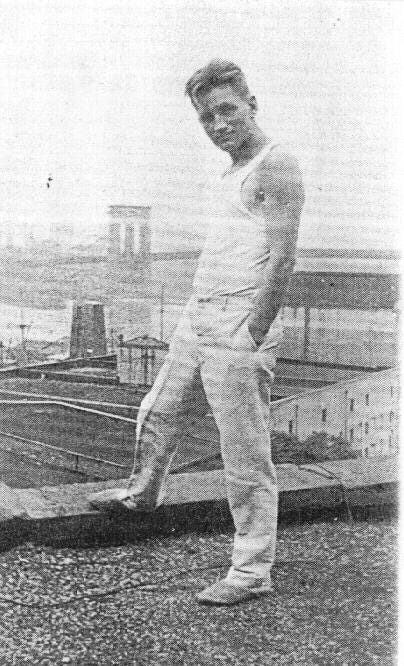Brooklyn, N.Y.
April 21st, [1924]Dear Waldo:
For many days, now, I have gone about quite dumb with something for which "happiness" must be too mild a term. At any rate, my aptitude for communication, such as it ever is!, has been limited to one person alone, and perhaps for the first time in my life (and, I can only think that it is the last, so far is my imagination from the conception of anything more profound and lovely than this love.) I have wanted to write you more than once, but it will take many letters to let you know what I mean (for myself, at least) when I say that I have seen the Word made Flesh. I mean nothing less, and I know now that there is such a thing as indestructibility. In the deepest sense, where flesh became transformed through intensity of response to counter-response, where sex was beaten out, where purity of joy was reached that included tears. It’s true, Waldo, that so much more than my frustrations and multitude of humiliations has been answered in this reality and I promise that I feel that whatever event the future holds is justified before hand. And I have been able to give freedom and life which was acknowledged in the ecstasy of walking hand in hand across the most beautiful bridge of the world, the cables enclosing us and pulling us upward in such a dance as I have never walked and never can walk with another. . . .HART CRANE TO WALDO FRANK
Today is the birthday of my favorite poet, Hart Crane. I don’t know why, but there are so many dear people in my life who were born in July: my father, on the 13th; my dead beloved (C.C.), who was born and died on his 21st birthday tragically, on the 6th; as well as John Ashbery, my sweet friend and nutty mentor of many years, born on the 28th (the same day as my grandfather, in fact).1
To pay tribute to Crane, I wanted to quote from one of this most famous letters (excerpted above).2
Hart Crane tragically committed suicide in April 27, 1932, while he was on the way back from Mexico. Accounts and interpretations vary, but he jumped off the back of the Orizaba into shark-infested waters in the Gulf of Mexico, slightly before noon. His body was never recovered (inspiring John Wheelwright’s epic elegy: “Fish Food”—which I often teach).3
For many decades, everything about the poet’s life was considered a failure, a splendid failure, gifted but damaged. Crane was a raging alcoholic who had a habit of ending friendships and making scenes. He was also an unapologetic homosexual, not a boon in any social age of American history, as well as another reason for friends and critics to turn on him, blaming his poetic style or suicide on a ‘disordered’ or ‘pathological’ nature.
To the degree he had one, the Danish sailor Emil Opffer was the love of Crane’s life. Opffer was a ship writer (journalist), and went on many long travels around the world. This made Crane a tad sulky. And I say this with love and identification, but it really brought out the moody-ass bitch in the young poet. As they became lovers, Crane’s poetry intensified. Typical poet shit: he was already trying to write some love poems, totally unrelated right before he met Emil. Yet finally the muse arrive. This erotic—and spiritual—experience crystallized something for Crane. He would work on them for years, the sequence now known as Voyages sprang into existence: what I still claim as the finest short sequence of love lyrics in the English language: dense and intricate, high-voltage and slightly impossible.4 They are so very tender in spots:
But now
Draw in your head, alone and too tall here.
Your eyes already in the slant of drifting foam;
Your breath sealed by the ghosts I do not know:
Draw in your head and sleep the long way home.
The story begins in April 1924, in Brooklyn, soon after Crane met the blond-haired, blue-eyed Opffer. In the above letter to a friend, with his typical rhetorical intensity, Crane marks the encounter by boasting at having seen “the Word made Flesh,” recalling the opening of the Gospel of John. But something in the next sentence always stayed with me even more: “I know now that there is such a thing as indestructibility.” I’ve felt that! Have you felt that?
To pay tribute to Crane, I want to ask, as earnest and intense as he was, no shame: Is there such a thing as indestructibility when it comes to love? The Romantic mode of looking at love, especially erotic, sexual or romantic love, something that happens between two or more partners, has been widely debunked from pop psychology, statistics, and anti-capitalist critique. It’s basically seen as a teenage fiction. Something to sell movies or trap people in unhappy marriages. I mean…
Let’s boil them down some soundbites on the supposed Realist side, that is, against the idea of indestructible love.



